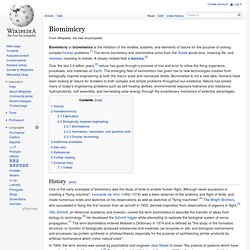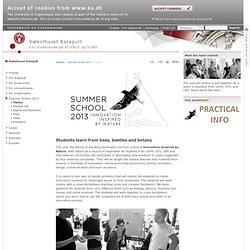

Research. We have a proud record of achievement in education and research in the Department.

The 2008 Research Assessment Exercise rated the majority of our research as "world-leading or internationally excellent. " Our research covers a full spectrum extending from fundamental investigations to applied research. Many of these activities are carried out in conjunction with industry and other universities, both in the UK and overseas. Research activities. Press Release - 09 May 2006 - University of Bath.
Copying nature could save us energy, study shows New technologies that mimic the way insects, plants and animals overcome engineering problems could help reduce our dependence on energy, according to new research published in the Royal Society journal Interface.

When faced with engineering difficulties, such as lifting a load or coping with extremes of heat, up to 70 per cent of man-made technologies manipulate energy, often increasing the amount used, in order to resolve the problem. However, new research which has compared how nature and man-made technologies overcome similar problems has shown that only 5 per cent of natural ‘machines’ rely on energy in the same way. Instead, insects, plants, birds and mammals rely on the structure and organisation of their body parts and behaviour; the solutions to problems are already built in. “An example might be a hammer,” said Professor Julian Vincent from the University of Bath who led the research . Press Release - 09 May 2006 - University of Bath. Chinese province recognises engineering at Bath.
Professor Julian Vincent, Honorary Professor of Biomimetics in the Department of Mechanical Engineering, has been awarded a Friendship Award by the Government of Jilin Province in China.

Professor Vincent has been given a Friendship Award for his work in the Jilin Province. The award, one of just five given by the province following over 500 nominations, recognises an outstanding contribution made by foreign experts in developing science and technology in the region. The annual award ceremony is held to celebrate the anniversary of the Province’s National Day and to thank foreign experts for their important contributions to the revitalisation of industrial Jilin and the promotion of sound and rapid economic development. Professor Vincent was initially asked to go to Jilin University, one of the largest and most successful Chinese universities, in 2005. Through his involvement in Jilin Province, Professor Vincent has made many local friends. If you enjoyed this article you might also like: Cgi-bin/GetTRDoc?AD=ADA428829. Biomimicry. Biomimicry or biomimetics is the imitation of the models, systems, and elements of nature for the purpose of solving complex human problems.[1] The terms biomimicry and biomimetics come from the Greek words bios, meaning life, and mimesis, meaning to imitate.

A closely related field is bionics.[2] Over the last 3.6 billion years,[3] nature has gone through a process of trial and error to refine the living organisms, processes, and materials on Earth. The emerging field of biomimetics has given rise to new technologies created from biologically inspired engineering at both the macro scale and nanoscale levels. Biomimetics is not a new idea. Humans have been looking at nature for answers to both complex and simple problems throughout our existence.
History[edit] One of the early examples of biomimicry was the study of birds to enable human flight. Nanobiomimicry[edit] Biological imitation of nano and micro scale structures and processes is called nanobiomimicry. Fabrication[edit] Experts and facilitators – University of Copenhagen. Theme: Innovation Inspired by Nature – University of Copenhagen. This year the theme of the Next Generation summer school is Innovation Inspired by Nature.

With nature as a source of inspiration 40 students from UCPH, DTU, CBS and international universities will participate in developing new solutions to cases suggested by four external companies. They will be taught the newest theories and methods from experts in the fields of innovation, entrepreneurship,biomimicry, bionics, evolution, design, communication and team dynamics. It is nature’s own way to handle problems that will inspire the students to create innovative solutions to challenges posed by four companies.
The students will work closely with a cross-disciplinary teaching corps and creative facilitators. We have gathered 40 students from very different fields such as biology, physics, business and human and social sciences. Students at work in cross-disciplinary teams. Biomimicry is composed by the word bios, e.g. life, and mimesis, e.g. to mimic.